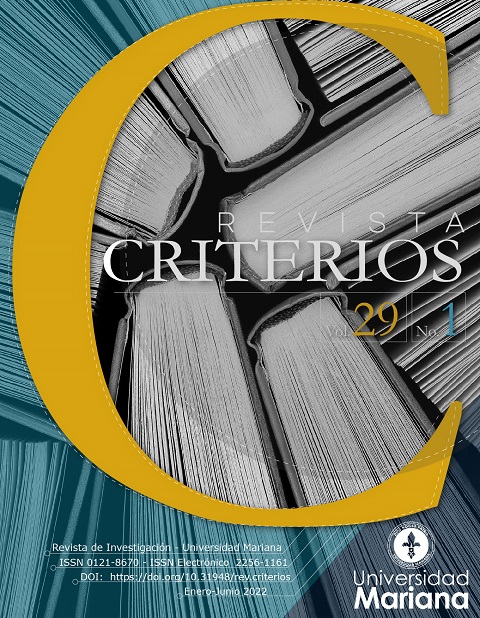Doronoke: Mobile application for learning data representation in the third-grade of the Educational Institution ‘Promoción Social Guatapurí’ of the Kankuamo indigenous people
DOI:
https://doi.org/10.31948/rev.criterios/29.1-art1Keywords:
Doronoke, mobile, learning, cultureAbstract
The present research aims to develop a Doronoke mobile application for the learning of data representation in third-grade students of the ‘Promoción Social Guatapurí’ Educational Institution of the Kankuamo Indigenous people. It is theoretically
supported from the approaches of Almeida, Cisneros, Galarza, the Ministry of National Education, the Kankuamo Indigenous Organization, Queiruga, among others. It was located in the post-positivist paradigm, with the methodology in Action Research that was developed in six phases: in the first, the statement of the problem; in the second, the literature review; in the third, the formulation and implementation of a plan; in the fourth, the collection of information; in the fifth, the analysis or evaluation of the information, and in the sixth, the report of the results. The work unit consisted of 17 third-grade students. The results indicated that the implementation of the didactic strategies was successful, by achieving all the proposed objectives and taking the first step so that the Kankuamo people continued in the line of building or strengthening applications, where learning takes place in context and is significant for their students, using technological tools.
Similarly, encourage motivation to obtain new knowledge and, at the same time, strengthen elements of culture; in this case, the Kankuama language. Since the Doronoke application is in its first version, a second one is suggested, with more
exercises on the subject of data representation, so that the desire to learn is more significant and, to continue providing feedback with the same contextualization of the medium. Later it is possible to think of including more learning content and other topics of statistics and mathematics itself in general.
Author Biographies
Arelis Esther Montero-Montero, Institución Educativa Promoción Social Guatapuri
Maestrante en Pedagogía; Licenciada en Educación Preescolar. Docente Titular de la Institución Educativa Promoción Social Guatapuri –Chemesquemena, Valledupar, Cesar
Sugeidis Beatriz Torres-Pacheco, Institución Educativa Promoción Social Guatapuri
Maestrante en Pedagogía; Licenciada en Matemáticas e Informática. Docente Titular de la Institución Educativa Promoción Social Guatapuri – Chemesquemena, Valledupar, Cesar, Colombia
Rolando Hernández-Lazo, Universidad Popular del Cesar
Máster en Informática en Salud mención Informática Educativa; Licenciado en Biología. Docente Universidad Popular del Cesar, Valledupar
References
Barragán, A. (2016). Desarrollo y aplicación de una estrategia didáctica para la integración del conocimiento a la enseñanza de la física en ingeniería. Innovación Educativa, 16(71),133-155.
Batanero, C. (2000). Controversies around the Role of Statistical Tests in Experimental. http://citeseerx.ist.psu.edu/viewdoc.1.1.598.4706&rep=rep1&type=pdf
Escudero, C.L. y Cortez, L.A. (2018). Técnicas y métodos cualitativos para la investigación científica. UTMACH Editorial. Hernández, R., Fernández, C. y Baptista, P. (2014). Metodología de la investigación (6.ªed.). McGraw-Hill / Interamericana Editores, S.A. de C.V.
Hurtado, J. (2010). Metodología de la investigación. Guía para la comprensión holística de la ciencia (4.a ed.). Quirón Ediciones.
Lowy, E. (1999). Utilización de Internet para la enseñanza de las ciencias. Didáctica de las Ciencias, (19), 65-72.
Ministerio de Educación Nacional (MEN). (1998). Serie Lineamientos Curriculares. Matemáticas. https://www.mineducacion.gov.co/1759/articles-89869_archivo_pdf9.pdf
Ministerio de Educación Nacional (MEN). (2006). Estándares Básicos de Competencias en Lenguaje, Matemáticas, Ciencias y Ciudadanas. https://www.mineducacion.gov.co/1621/article-116042.html
Ñaupas, H., Valdivia, M.R., Palacios, J.J. yRomero, H.E. (2018). Metodología de la investigación cuantitativa, cualitativa y redacción de la tesis (5.a ed.). Ediciones de la U.
Organización Indigena Kankuama. (2008).Makú jogúki. Ordenamiento educativo del pueblo indigena kankuamo. Fundación E-Korúa.
Tamayo y Tamayo, M. (2004). El proceso de la investigación científica (4.ª ed.). Limusa Noriega Editores.
How to Cite
Downloads
Downloads
Published
Issue
Section
License

This work is licensed under a Creative Commons Attribution 4.0 International License.
Revista Criterios es publicada por la Editorial UNIMAR de la Universidad Mariana bajo los términos de la licencia Creative Commons Reconocimiento 4.0 Internacional (CC BY 4.0)

| Article metrics | |
|---|---|
| Abstract views | |
| Galley vies | |
| PDF Views | |
| HTML views | |
| Other views | |




